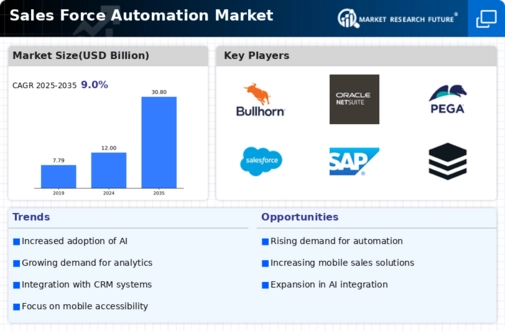Market Growth Projections
The Global Sales Force Automation Market Industry is poised for substantial growth, with projections indicating a market size of 30.8 USD Billion by 2035. This anticipated growth reflects the increasing adoption of sales automation technologies across various sectors. The market's compound annual growth rate of 8.95% from 2025 to 2035 suggests a robust demand for innovative solutions that enhance sales efficiency and effectiveness. As organizations continue to recognize the value of automation in driving sales performance, the market is expected to expand significantly, presenting opportunities for both established players and new entrants.
Increasing Demand for Automation
The Global Sales Force Automation Market Industry experiences a notable surge in demand for automation solutions. Businesses increasingly seek to streamline their sales processes, enhance productivity, and improve customer engagement. Automation tools enable sales teams to manage leads, track interactions, and analyze performance metrics efficiently. As a result, the market is projected to reach 12 USD Billion in 2024, reflecting a growing recognition of the benefits of automation in driving sales success. Companies that adopt these technologies often report improved sales conversion rates and enhanced customer satisfaction, indicating a shift towards data-driven decision-making in sales.
Expansion of Cloud-Based Solutions
The shift towards cloud-based solutions significantly influences the Global Sales Force Automation Market Industry. Cloud technology offers scalability, flexibility, and cost-effectiveness, making it an attractive option for businesses of all sizes. Organizations can access sales automation tools from anywhere, facilitating remote work and collaboration among sales teams. This trend is particularly relevant as companies seek to adapt to changing work environments. The convenience of cloud-based solutions is expected to drive market growth, with businesses increasingly adopting these technologies to enhance their sales processes and improve overall efficiency.
Growing Importance of Data Analytics
The growing importance of data analytics in the Global Sales Force Automation Market Industry cannot be overstated. Organizations are increasingly leveraging data to inform their sales strategies and decision-making processes. Sales automation tools equipped with advanced analytics capabilities allow businesses to gain insights into customer behavior, sales trends, and market dynamics. This data-driven approach enables sales teams to optimize their efforts and allocate resources more effectively. As the demand for actionable insights continues to rise, the integration of robust analytics features into sales automation solutions is likely to become a key driver of market growth.
Integration of Artificial Intelligence
The integration of artificial intelligence within the Global Sales Force Automation Market Industry appears to be a transformative trend. AI technologies facilitate predictive analytics, enabling sales teams to identify potential leads and tailor their approaches accordingly. This capability not only enhances efficiency but also allows for more personalized customer interactions. As AI continues to evolve, its applications in sales automation are expected to expand, potentially driving market growth. The anticipated compound annual growth rate of 8.95% from 2025 to 2035 underscores the importance of AI in shaping the future of sales automation, as organizations leverage these tools to gain a competitive edge.
Rising Focus on Customer Relationship Management
A growing emphasis on customer relationship management (CRM) is shaping the Global Sales Force Automation Market Industry. Organizations recognize that maintaining strong customer relationships is crucial for long-term success. Sales force automation tools that integrate seamlessly with CRM systems enable businesses to track customer interactions, preferences, and feedback effectively. This integration fosters a more holistic understanding of customer needs, allowing sales teams to tailor their strategies accordingly. As companies increasingly prioritize customer-centric approaches, the demand for sales automation solutions that enhance CRM capabilities is likely to rise, contributing to the market's projected growth.

















Leave a Comment